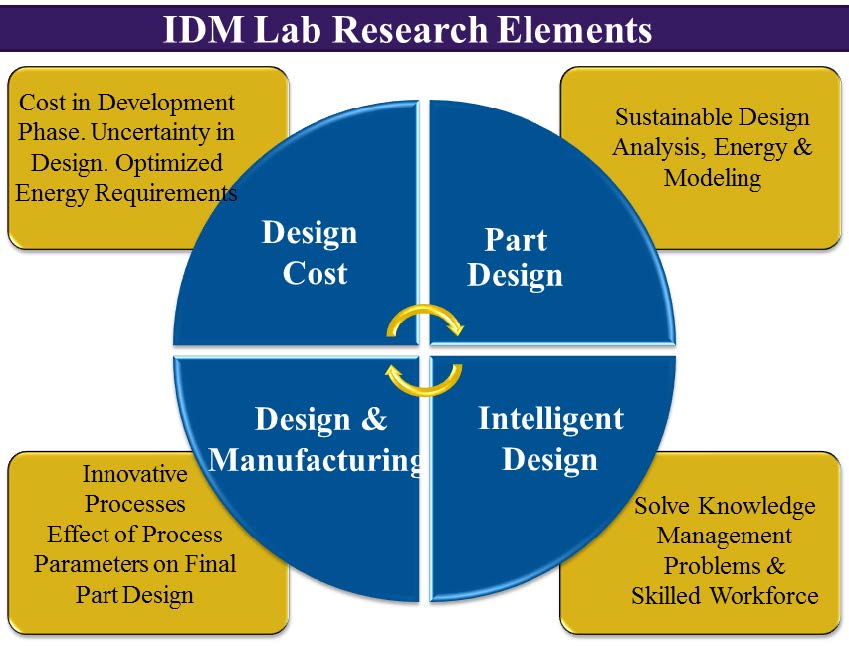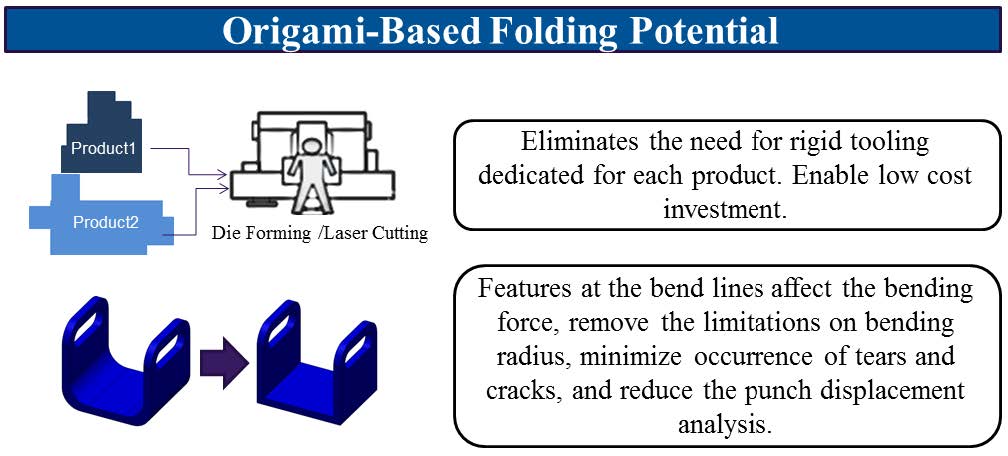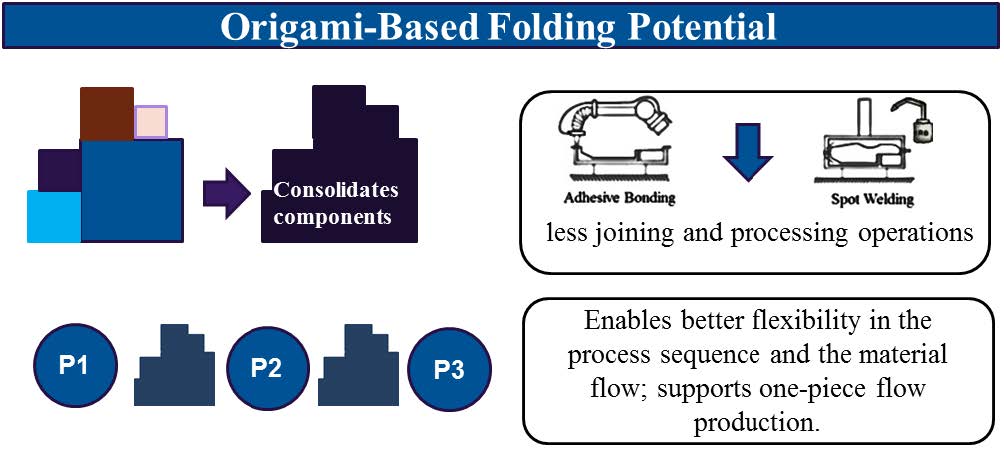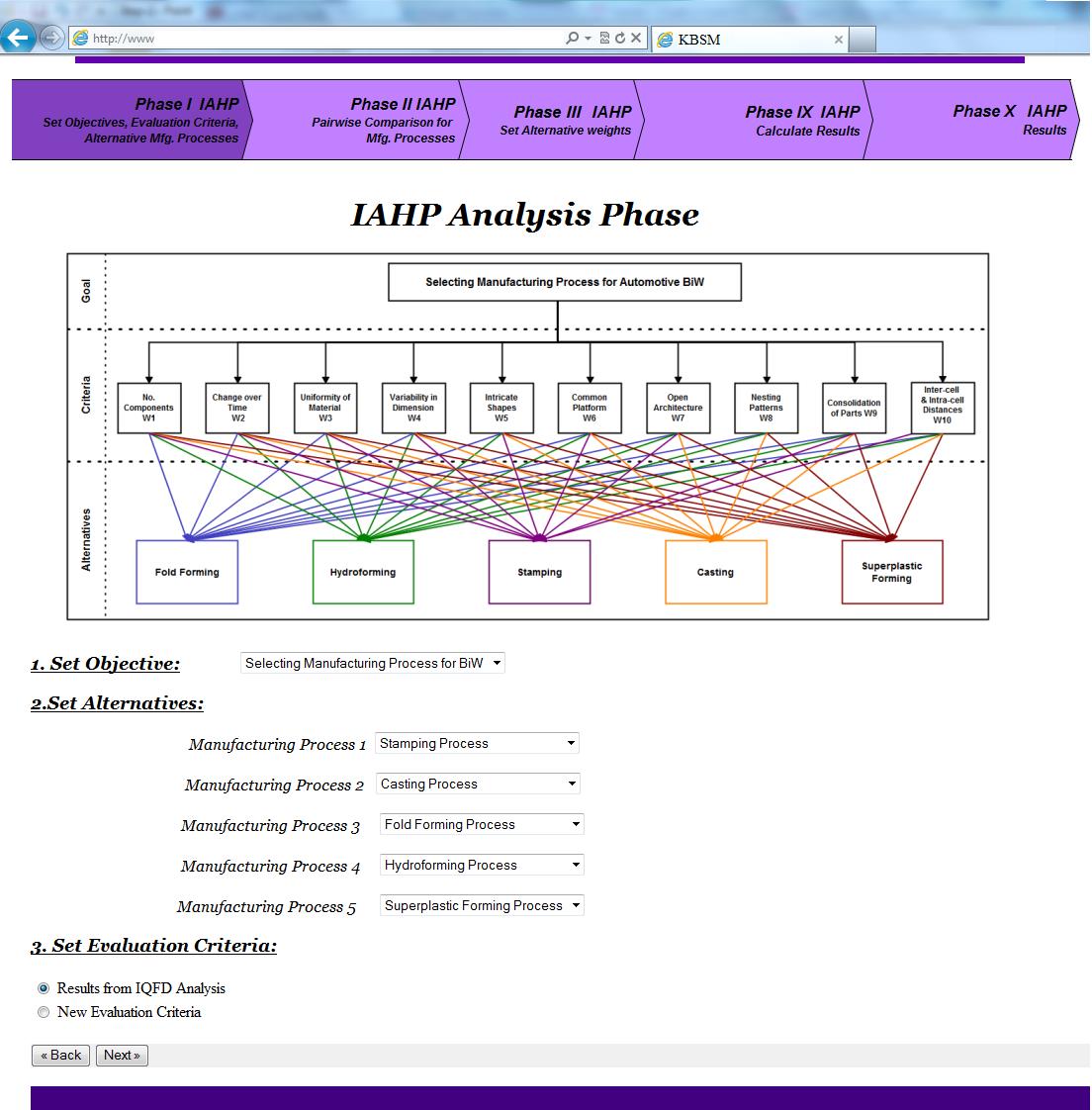Innovative Design & Manufacturing (IDM) Research Program
 The innovative design and manufacturing research program (IDM) focuses on the broad area of design and manufacturing with an emphasis on the aspects of modeling and optimization of innovative processes and part design, intelligent manufacturing systems, and sustainable design and manufacturing processes. These various facets of research serve the overall objective of developing analytical methodologies and tools that reinforce the design of both the manufacturing process and the product for scalable production volume with low capital investment. Primarily,
The innovative design and manufacturing research program (IDM) focuses on the broad area of design and manufacturing with an emphasis on the aspects of modeling and optimization of innovative processes and part design, intelligent manufacturing systems, and sustainable design and manufacturing processes. These various facets of research serve the overall objective of developing analytical methodologies and tools that reinforce the design of both the manufacturing process and the product for scalable production volume with low capital investment. Primarily,
The IDM Lab blends the following research objectives:
- Design-for-manufacturing;
- Design-for-assembly;
- Sustainable design
- Design process capturing and automating using Knowledge-Based Systems (KBS);
- Optimized design and process costs.
Introduction
The direction of IDM research is the key to enabling new levels of the nation’s innovation in the design and manufacturing for the short-term and long-term economic impacts. In order to produce sustainable products and manufacturing procedures, it is necessary to establish adequate knowledge regarding the best design practices necessary for design and production, in addition to the measuring indices that indicate feasibility. At the present, through the use of recently developed innovative manufacturing processes such as 3-D printing (for polymer and metal materials), origami-based fold forming, and metal foam, novel parts with unique characteristics and less investment costs are feasible.
Projects
Examples of current projects and future research directions in IDM lab (Link to the IDM Lab) include:
- Investigating the effect of materials discontinues on the mechanical behavior of origami-based folded sheet metal products
- Optimize the design of components produced by direct metal laser sintering process for high value added metals
- Developing Mythologies & Measures for Sustainable Manufacturing
- Knowledge-Driven Manufacturing for Sustainable Design Practices
Investigating the effect of materials discontinues on the mechanical behavior of origami-based folded sheet metal products
IDM Lab research agenda concentrates on exploring the absolute mechanical behavior and characteristics of origami-based engineering products. IDM Lab provides a better understanding of the design optimization for such an innovative manufacturing approach, especially when the parts are used as load bearing entities. The IDM Lab investigates the relation between the part geometry and the mechanical properties (i.e. material discontinues shape, number, and location vs. static parts load bearing characteristics). Additionally, the research considers the material discontinuity effect on the folding operation (i.e. accuracy, force requirements, and developed cracks/tears). The methodology uses mechanical testing with a real on-time simulation of material parts displacement and plastic deformation under a predefined set of loads.


Optimize the design of components produced by direct metal laser sintering process for high value added metals
3-D printing is one of the most interesting research topics, especially in regards to combining the lightweight aspect in metal components with loadbearing requirements, as with vehicle body parts fabricated by Direct Metal Laser Sintering (DMLS). DMLS is an emerging-manufacturing technology that offers flexible and fast fabrication in terms of process with no need for molds or dies as in traditional processes. In addition, DMLS is able to generate complex geometries with high accuracy and minimal needs for secondary operations directly from a CAD file. IDM Lab (Link to main page of IDM lab) research aims at understanding the mechanical properties of such components to set the major optimization features for loadbearing products. In order to understand DMLS parts characteristics, many variables require investigation, mainly the influential parameters can be categorized into geometry related (i.e. surface roughness, stress concentration, and aspect ratio), process related (i.e. layer build direction either vertically or horizontally, layer thickness, and laser dimension), and bulk material related (i.e. material type). All of these factors contribute to the yield and ultimate strength values, fatigue life (i.e. dynamic material properties), and the need for secondary machining. To achieve the lightweight needs with loadbearing, IDM Lab focuses on high value added metals such as nickel, titanium, and steel based alloy materials.
Developing Mythologies & Measures for Sustainable Manufacturing
 Currently, there is a need to develop indices and measures that define sustainability aspects within manufacturing, thus creating a general evaluation methodology. A broader context develops major performance indicators for sustainable manufacturing process that can be quantified and measured within an industry.
Currently, there is a need to develop indices and measures that define sustainability aspects within manufacturing, thus creating a general evaluation methodology. A broader context develops major performance indicators for sustainable manufacturing process that can be quantified and measured within an industry.
The derivation of the indicators highlights the economic, societal, and environmental aspects of the product production line. This entitles classification of product material types, design, usage, life range, and energy requirements, all within the context of sustainability. The research creates multi-attributes cost models that consider quantitative and qualitative measure for sustainability aspects.
One major driving factor for change in the future of manufacturing and design is the energy and sustainability aspects. Therefore, IDM Lab research interests also focuses on sustainable manufacturing. Particularly, it considers the modeling and evaluation techniques for the sustainability aspects in product design, with an emphasis on the automotive industry.
Knowledge-Driven Manufacturing for Sustainable Design Practices
 Cost is a major factor in any feasible design, especially with the higher demand for using innovative manufacturing technologies and approaches. Building robust and effective cost models requires comprehensive life cycle assessment of the product. This is a challenging requirement, particularly for vehicles. The automotive industry faces considerable regulation and customers’ needs, which the manufacturer desires to satisfy within the minimal manufacturing cost. However, cost modeling for manufacturing considers the cost of a specific part based on the design and fabrication perceptions. Other measures should be included, such as environmental, recycling, maintenance, and replacement costs. Their inclusion requires defining design parameters that can be considered in the early stages of the design to produce an optimized alternatives within the life cycle cost envelop.
Cost is a major factor in any feasible design, especially with the higher demand for using innovative manufacturing technologies and approaches. Building robust and effective cost models requires comprehensive life cycle assessment of the product. This is a challenging requirement, particularly for vehicles. The automotive industry faces considerable regulation and customers’ needs, which the manufacturer desires to satisfy within the minimal manufacturing cost. However, cost modeling for manufacturing considers the cost of a specific part based on the design and fabrication perceptions. Other measures should be included, such as environmental, recycling, maintenance, and replacement costs. Their inclusion requires defining design parameters that can be considered in the early stages of the design to produce an optimized alternatives within the life cycle cost envelop.
This research is being led by the IDM Lab (PI: Dr. Ala Qattawi)



